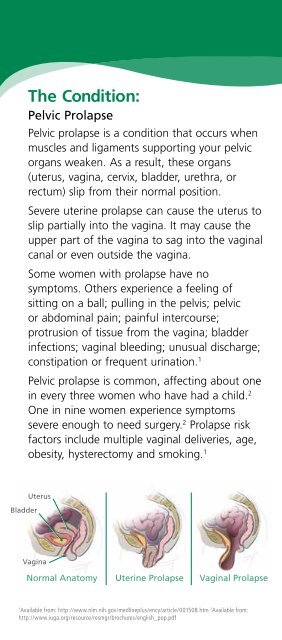da Vinci® Sacrocolpopexy Patient Brochure - Sparks & Favor PC
da Vinci® Sacrocolpopexy Patient Brochure - Sparks & Favor PC
da Vinci® Sacrocolpopexy Patient Brochure - Sparks & Favor PC
Create successful ePaper yourself
Turn your PDF publications into a flip-book with our unique Google optimized e-Paper software.
Bladder<br />
The Condition:<br />
Pelvic Prolapse<br />
Pelvic prolapse is a condition that occurs when<br />
muscles and ligaments supporting your pelvic<br />
organs weaken. As a result, these organs<br />
(uterus, vagina, cervix, bladder, urethra, or<br />
rectum) slip from their normal position.<br />
Severe uterine prolapse can cause the uterus to<br />
slip partially into the vagina. It may cause the<br />
upper part of the vagina to sag into the vaginal<br />
canal or even outside the vagina.<br />
Some women with prolapse have no<br />
symptoms. Others experience a feeling of<br />
sitting on a ball; pulling in the pelvis; pelvic<br />
or abdominal pain; painful intercourse;<br />
protrusion of tissue from the vagina; bladder<br />
infections; vaginal bleeding; unusual discharge;<br />
constipation or frequent urination. 1<br />
Pelvic prolapse is common, affecting about one<br />
in every three women who have had a child. 2<br />
One in nine women experience symptoms<br />
severe enough to need surgery. 2 Prolapse risk<br />
factors include multiple vaginal deliveries, age,<br />
obesity, hysterectomy and smoking. 1<br />
Uterus<br />
Vagina<br />
Normal Anatomy Uterine Prolapse Vaginal Prolapse<br />
1 Available from: http://www.nlm.nih.gov/medlineplus/ency/article/001508.htm 2 Available from:<br />
http://www.iuga.org/resource/resmgr/brochures/english_pop.pdf


